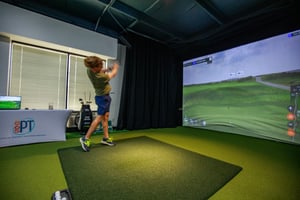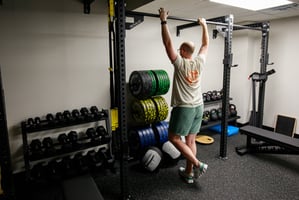Golf may seem low-impact at a glance, but it demands a complex mix of mobility, strength, balance,...
Best Exercises to Boost Rotational Power in Golf
In golf, rotational power is the engine behind your swing. It’s what allows you to generate clubhead speed, hit the ball farther, and maintain control throughout your round. Rotational power is a coordinated blend of mobility, core stability, and timing.
Without strong rotation, golfers often compensate with their arms or lower back, which leads to inefficient mechanics and a higher risk of overuse injuries. This is especially true for amateur players who may lack the physical foundation to repeat their swing under stress or fatigue.
READ: The Science Behind Effective Injury Prevention: How Physical Therapy Keeps Athletes at Their Best
Building rotational power gives you more than distance as it improves balance, consistency, and endurance. Whether you’re driving off the tee or fine-tuning your short game, your ability to rotate efficiently makes a noticeable difference in performance.

At 865 PT, we see rotational deficits every day in our golf clients. That’s why we’ve built our training model around identifying and improving rotational power from the ground up, using strategies backed by TPI methodology and cutting-edge tools like our in-clinic golf simulator.
The TPI Approach to Golf Performance
At 865 PT, we take a science-driven approach to golf performance, starting with the Titleist Performance Institute (TPI) framework. Being TPI Certified means we understand how to evaluate a golfer’s movement patterns and identify physical limitations that directly affect swing efficiency and power output.
The TPI screen is a specialized movement assessment that helps us pinpoint where your body may be restricting your rotation. For example, limited thoracic spine mobility or poor core engagement can disrupt the kinetic chain, meaning your power never transfers effectively from your legs to the club.
Rather than guessing or applying a generic program, we use your TPI screen results to design corrective exercises that restore function and build capacity. It’s a targeted process that eliminates compensations and optimizes how your body moves through the swing.
READ: 5 Signs You Could Benefit from Golf Physical Therapy in Knoxville
Combined with our golf simulator technology, the TPI approach allows us to assess, treat, and track progress in a way that’s specific to the demands of your game.
Foundational Mobility Exercises for Rotation
Before you can build power, you need to unlock the joints responsible for efficient rotation. That’s why mobility work forms the foundation of any effective rotational training program, especially for golfers.
At 865 PT, we often start with exercises that target the thoracic spine, hips, and shoulders, which are the areas that most commonly limit a golfer’s range. When these regions are stiff, you’re forced to generate rotation elsewhere, usually from the lower back, which puts you at greater risk for injury.
Some of our go-to mobility drills include:
- Open Books and Reach-Throughs for thoracic spine mobility
- 90/90 Hip Rotations and Lateral Lunges to improve hip rotation and control
- Wall Angels and Shoulder Dislocates for shoulder mobility and posture correction
These exercises are about creating usable motion that transfers to your golf swing. By restoring proper joint mobility, we make space for clean, powerful movement patterns that you can build on in later phases of your program.
Strength-Based Movements That Build Torque
Once mobility is established, it’s time to build strength in the planes of motion that matter especially rotational strength. At 865 PT, we use targeted exercises that train your body to create and control torque, which is essential for generating speed without sacrificing stability.
Here are a few key movements we integrate:
- Cable Rotations: These teach core control and allow for resistance through the entire range of motion, mimicking the demands of a golf swing.
- Medicine Ball Rotational Throws: These explosive exercises build rotational power and teach your body how to transfer force efficiently from the ground up.
- Banded Lifts and Chops: These emphasize diagonal strength patterns and reinforce the connection between your hips, core, and upper body.
The goal isn’t just to get stronger, it’s to train the muscles and movements you actually use in your swing. Each of these exercises helps refine your ability to generate speed while maintaining balance and control throughout the motion.
READ: Managing Chronic Pain Through Physical Therapy: Long-Term Relief in Knoxville
Every movement is adjusted based on your TPI screen and physical capacity, ensuring that your strength work translates directly to better performance on the course.
How We Integrate These Movements at 865 PT
At 865 PT, we build an integrated plan that connects your mobility, strength, and sport-specific goals. Everything we do is rooted in your TPI screen results and guided by real-time feedback from our in-clinic golf simulator.
The simulator plays a key role in bridging the gap between training and performance. As you progress through mobility and strength phases, we use the simulator to assess how those physical gains are impacting your swing. Are you rotating more efficiently? Generating more clubhead speed? Maintaining balance through impact? The data gives us answers.
Your program is updated based on what your body needs, and what the numbers show. This dynamic, personalized approach ensures that every drill and session moves you closer to your goals, whether that’s pain-free play or longer drives off the tee.
If you're looking for a smarter, more measurable way to improve your rotational power, our team at 865 PT is ready to help. Schedule your evaluation today and experience the difference a TPI-informed, tech-enhanced program can make.




